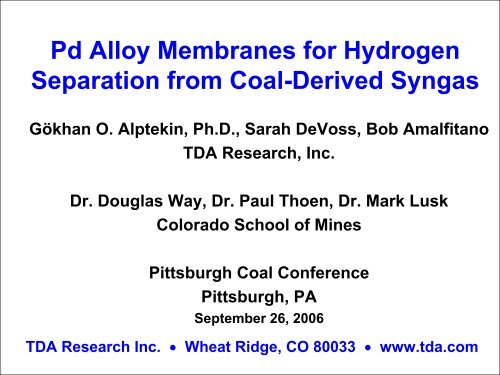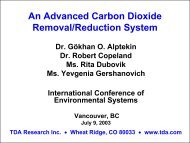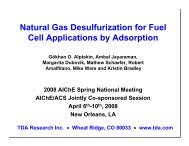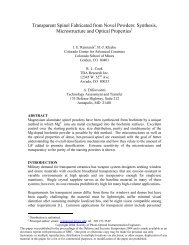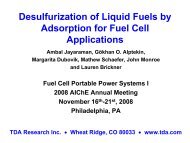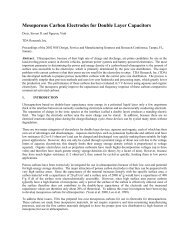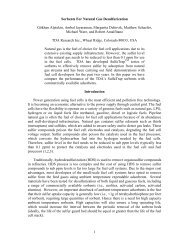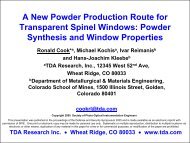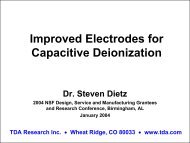Pd Alloy Membranes for Hydrogen Separation from Coal-Derived ...
Pd Alloy Membranes for Hydrogen Separation from Coal-Derived ...
Pd Alloy Membranes for Hydrogen Separation from Coal-Derived ...
You also want an ePaper? Increase the reach of your titles
YUMPU automatically turns print PDFs into web optimized ePapers that Google loves.
• Requirements• High H 2 flux• High H 2 purityMembrane Requirements• Robustness and resistance to degradation by thermal cycling• Operation at the right temperature range (260-450 o C)– Above the dew point of the syngas but low enough to achieveeffective contaminant control• Tolerance to all components of coal-derived synthesis gas– Particularly to sulfur• Potential Technologies <strong>for</strong> H 2 <strong>Separation</strong>• Pressure Swing Adsorption (PSA)• Ceramic membranes• Dense ceramic membranes• Our approach is composite <strong>Pd</strong> alloy membranes• CSM carries out film deposition and characterization• TDA carries out support development, membrane testing andmodule development3 TDAR e s e a r c h
Why <strong>Pd</strong> <strong>Membranes</strong>?• Potential <strong>for</strong> perfect H 2 selectivity• The transport mechanism isunique to hydrogen• Palladium catalyzes thedissociation of molecular H 2 intoatomic H• H atom is soluble in <strong>Pd</strong> metal andtransports through a solutiondiffusionmechanism• H atoms recombine at the lowpressure side and desorb <strong>from</strong> thesurface• Potential <strong>for</strong> high flux• Flux and permeability a function ofsolubility and diffusion rate4 TDAR e s e a r c h
Why <strong>Pd</strong> <strong>Alloy</strong> <strong>Membranes</strong>?• <strong>Membranes</strong> based on pure <strong>Pd</strong> suffer<strong>from</strong> embrittlement and cracking due tothe α→β <strong>Pd</strong> hydride phase transition (at~300 o C)• FCC to BCC phase change causesstructural de<strong>for</strong>mations in the film• <strong>Pd</strong> alloys avoids the α→β phasetransition in pure <strong>Pd</strong>• <strong>Alloy</strong>ing eliminates swelling, warping,cracking due to phase transitions• Eliminates the problems associatedwith thermal cyclesα phase is FCCβ phase is BCC• Some <strong>Pd</strong> alloys shows higher permeability than the pure <strong>Pd</strong>• 27% Ag, 6% Ru, 40% Cu, 5% Au alloys have shown to have muchhigher fluxes than pure <strong>Pd</strong> films• Additional benefits of alloying• Reduced cost (depending on the selected component)• Resistant to H 2 S• Dimensional stability (small degree of swelling)5 TDAR e s e a r c h
Why <strong>Pd</strong> Composite <strong>Membranes</strong>?• <strong>Pd</strong> alloys can be prepared into selfsupporting structures or can be prepared onporous supports (i.e., composite membranes)as thin films• Thin films increases the H 2flux at a givenpressure• Flux equation in <strong>Pd</strong> membranes (Way, 1996)( )J H= P Hl mp H2 , feed − p H 2, permeate• Low cost when the alloys made into thinalloy films• 5 µm <strong>Pd</strong>Cu (60/40) film– <strong>Pd</strong> cost = $20/ft 2 Cu Cost = 0.70/ft 2• 25 µm <strong>Pd</strong>Cu alloy will cost 5 times highermaterial cost and its flux will be much lower• The original idea is <strong>from</strong> the work of Uemiyaand Kikuchi, Chem. Lett., 1687, 1988• The challenge is how to make them andoperate them at high pressures1 µm thick composite<strong>Pd</strong>Cu membrane2 µm thickcomposite <strong>Pd</strong>Cumembrane6 TDAR e s e a r c h
Porous Supports <strong>for</strong> Deposition of <strong>Pd</strong> Films• Previous work at CSM focused on preparing thin <strong>Pd</strong>or <strong>Pd</strong> alloy films on ceramic supports• <strong>Pd</strong> alloy film thickness ~1-5 µm• Supports are commercially available by CoorsTek,and Pall originally developed <strong>for</strong> gas filtration• The substrates can be symmetric (constant pore size)or asymmetric (gradient in pore size)• Symmetric ceramic supports• Low cost– Symmetric Supports ~ $25/ft 2– Asymmetric Supports > $500/ft 2• Higher strength, less defectsAsymmetric SupportSymmetric Support• Membrane film isdeposited either on theinside or outside diameterof the porous supports8 TDAR e s e a r c h
Preparation of <strong>Pd</strong> <strong>Alloy</strong> Films on Steel Supports• Porous steel supports increases therobustness over the ceramic supports• It is much easier to incorporate themetal supported membranes intomodules• Welding or brazing• Elimination of ceramic/metal jointsminimize leaks• Issues need to be addressed:• Surface roughness– Thicker films are required• Inter-metallic diffusion– Cause <strong>for</strong>mation of an undesiredalloy• A diffusion barrier addresses all these problems:• An oxide layer diffusion barrier deposited on steel support prior toplating prevent diffusion of <strong>Pd</strong> membrane and support• If the oxide layer diffusion barrier can be applied is in the <strong>for</strong>m of smallparticles, surface roughness may be reduced9 TDAR e s e a r c h
Module Construction• The final membrane module or themembrane-WGS reactor will be similarto a shell-and-tube type heat exchangerNonporous wall ofmembrane reactorSteam SweepTubular symmetricstainless steelmembrane supportH 2PermeateHigh H 2topurity fuel cell H 23 kW e<strong>Pd</strong>/Cu filmCO-rich re<strong>for</strong>mateSulfur TolerantWGS CatalystCO + H 2 O = CO 2 + H 2Sulfur-richResidueN 2, CO,CO 2, H 2O,H 2S andsome H 2To be burnedwith O 2Porous Stainless Steel Tube (ACCUSEP by Pall)Steam SweepH 2PermeateH 2toTubular fuel cellmembranes7 ACCUSEP kW e tube with removable compression fittingsWeldjointNon-poroussteel tubePoroussteel tubeACCUSEP tubes weldedto the tubesheet10 TDAR e s e a r c h
• IntroductionOutline• Background on Composite <strong>Pd</strong> <strong>Alloy</strong><strong>Membranes</strong>• Results• Sulfur Tolerant Composite <strong>Pd</strong>Au <strong>Membranes</strong>• Metal Supported <strong>Pd</strong>Au Membrane• Future Work11 TDAR e s e a r c h
Molecular Modeling• Molecular Dynamics Simulation is used to identify a promising <strong>Pd</strong>alloy composition that provides high flux and sulfur resistance• <strong>Pd</strong>Cu and <strong>Pd</strong>Au alloys were selected <strong>for</strong> initial considerations• <strong>Pd</strong>-rich alloys were examined both because of their lower cost and higherper<strong>for</strong>mancePolycrystalline arrangementsFocus:Au<strong>Pd</strong> 3 regionSROLROSROSROLROSROLROAll crystal structure in diagramare FCCAu 50<strong>Pd</strong> 50Au 25<strong>Pd</strong> 75• Atomistic studies were per<strong>for</strong>med to measure rate of H atomdiffusion through Au-<strong>Pd</strong> 3 lattice at 300-400 o C range12 TDAR e s e a r c h
Diffusion of H through <strong>Pd</strong>Au <strong>Alloy</strong>• Molecular simulation results showed that H atom transport in the<strong>Pd</strong> 75 Au 25 matrix is slower than it is in the <strong>Pd</strong> 60 Cu 40 at 400 o C• Both lattices are dilated to the same extent lattice to increasediffusivity<strong>Pd</strong><strong>Pd</strong><strong>Pd</strong>AuAuAu<strong>Pd</strong>Au<strong>Pd</strong>Au<strong>Pd</strong>AuTrap 1 Trap 2• Au atoms act as effective trap sites <strong>for</strong> H atom and slow thediffusion rate• Slower transport rates are correlated to higher activation energy <strong>for</strong>H diffusion13 TDAR e s e a r c h
Membrane Preparation• Several <strong>Pd</strong>Cu and <strong>Pd</strong>Au composite membranes were developed<strong>for</strong> testing• EDX analysis indicates that membrane consists of 87% <strong>Pd</strong> and13% Au• Small number of spots or defects in the surface of the membrane• Nitrogen leak rate measurements show that the surface defects do notpenetrate the entire thickness of the membrane15 TDAR e s e a r c h
Membrane Testing SystemThermocoupleportTest apparatusFeed InMembrane moduleShell (1.0 in)Tube (0.25 in)MembranemodulePermeateResidueThermocoupleportSub-ppm level sulfur detection capability withSievers Chemiluminescence Detector16 TDAR e s e a r c h
Baseline Per<strong>for</strong>mance of <strong>Pd</strong>Au MembraneT=400 o C, P feed = 100 psig, P perm = 2 psig, Feed H 2 /H 2 O/CO/CO 2 Conc. = 51/21/26/2350300Hours92-97of theTestHours 140-147 of theTestHours 198-205 of theTestHours 315-331 of theTest250200150Permeate (sccm)10050H 2permeation rate=32.5 sccm/cm 2 or64 scfh/ft 2Permeation Tests, CO2 test, Air PurgeWater Gas Shift Testing (400°C,various pressures)Water Gas Shift Testing (450°C), Air Purge, H2/N2test, Water Gas Shift Testing (450°C),Water Gas Shift Temperature Testing, Flow RateTests, Pressure Tests, CO/CO2 Test H2/N2 test0• A stable membrane per<strong>for</strong>mance (i.e., H 2permeation and selectivity) wasobserved <strong>for</strong> over 300 hrs in the presence of CO, CO 2, H 2O and H 2mixTime17 TDAR e s e a r c h
Effect of H 2 S on <strong>Pd</strong>Au MembraneT=400 o C, P feed = 100 psig, P perm = 2 psig, Feed H 2 /H 2 O/CO/CO 2 Conc. = 51/21/2/26Permeate (sccm), Permeate CO (ppm)30025020015010050Re<strong>for</strong>mateCO1 ppm H 2 S inRe<strong>for</strong>mate5 ppm H 2 S inRe<strong>for</strong>matePermeateCO21 ppm H 2 S inRe<strong>for</strong>mateRe<strong>for</strong>mate1.41.210.80.60.40.2Permeate CO 2 (%)00 1000 2000 3000 4000 5000 6000 7000 8000 9000Time (min)• With the introduction of sulfur to the syngas feed H 2permeation ratedecreased (5 ppmv sulfur caused 40% decrease)• When sulfur flow was stopped, membrane per<strong>for</strong>mance recovered18 TDAR e s e a r c h0
<strong>Pd</strong>Au on Porous Steel SubstratesTreatment of theporous steel tubes(elimination of oils,grease etc <strong>for</strong> theapplication ofcoating)Hermatic sealing ofthe ends of theporous steel tubesApplication of anoxide diffusionbarrierDeposition of <strong>Pd</strong> film(followed withdeposition of goldand proper annealing19 TDAR e s e a r c h
Evaluation of <strong>Pd</strong>Au on Porous SteelT=400 o C, P feed = 100 psig, P perm = 2 psig, Feed H 2 /H 2 O/CO/CO 2 Conc. = 51/21/2/262250.2Permeate (sccm),Permeate CO (ppmv)200175150125100755025Corresponds to a fluxof 31 scc/cm 2 min (61 scfh/ft 2 )CO averages less than 5 ppmv0.180.160.140.120.10.080.060.040.02Permate CO2 (%)000 50 100 150 200 250 300 350Time (min)• The <strong>Pd</strong>Au membrane prepared on porous steel support showed improvedselectivity indicating non-selective transport is most likely due to the seals• Even with a thicker film, H 2permeation rate of this membrane matched tothat prepared on ceramic support20 TDAR e s e a r c h
Future Work• Work on reducing the thickness of the membranefilm over the porous steel supported (PSS)membranes• Evaluate per<strong>for</strong>mance of the PSS membranes inthe presence of H 2 S• At sulfur concentrations up to 100 ppmv• Evaluate the potential problems associated withother coal gas contaminants• Arsenic, selenium, HCl …• Module design and development• H 2 separation module• Membrane Water-Gas-Shift Reactor21 TDAR e s e a r c h
Acknowledgements• DOD SBIR Phase I (Contract No. W56HSV-06-C0077)• Contract Monitor: Mr. Dan Maslach• DOE SBIR Phase I Project• Contract Monitor: Ms. Patricia Rawls22 TDAR e s e a r c h


